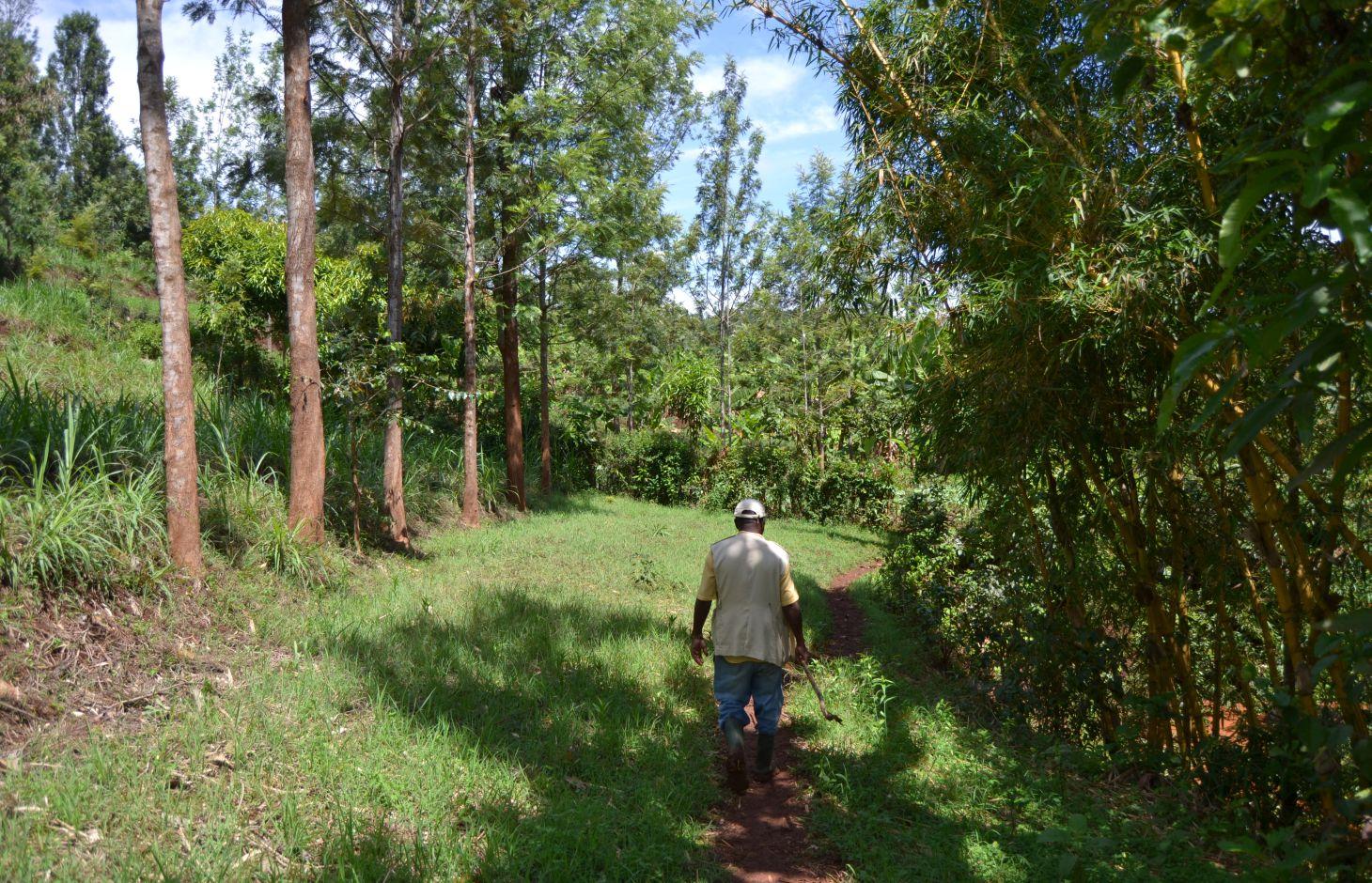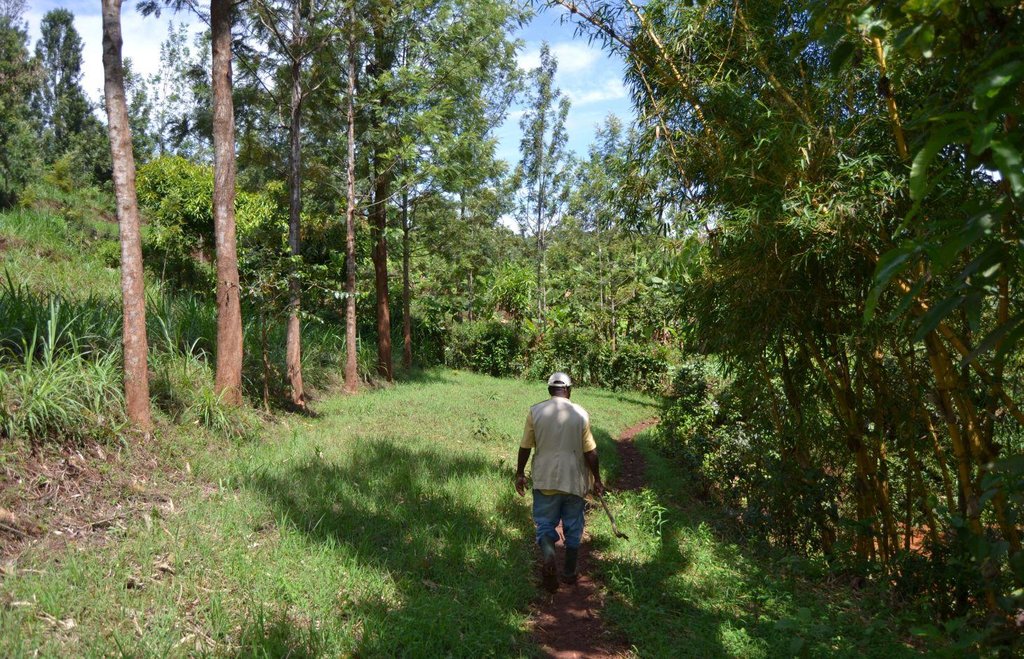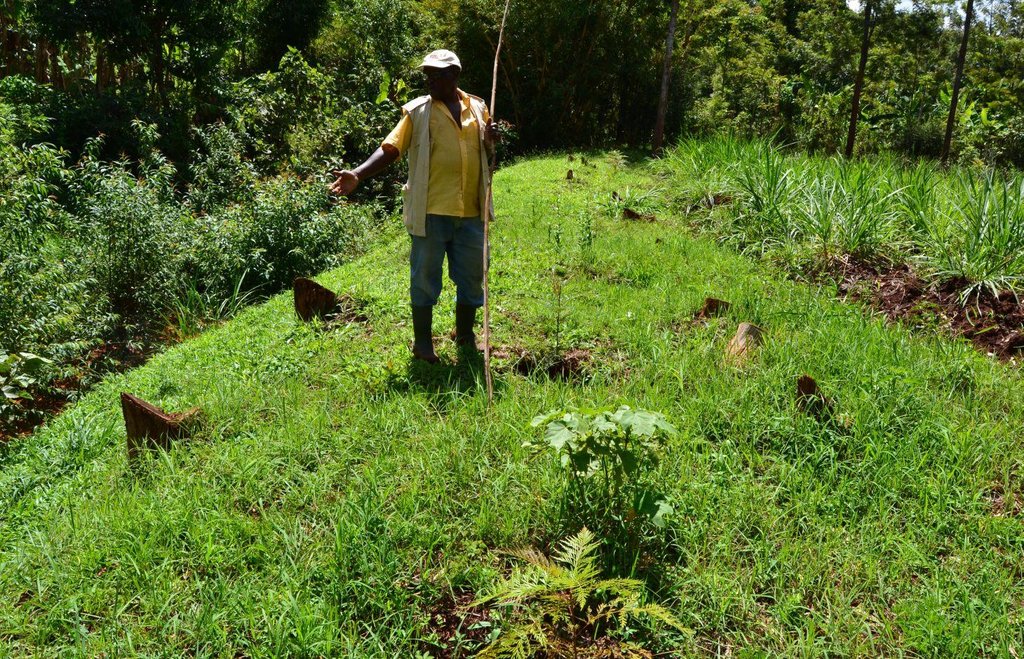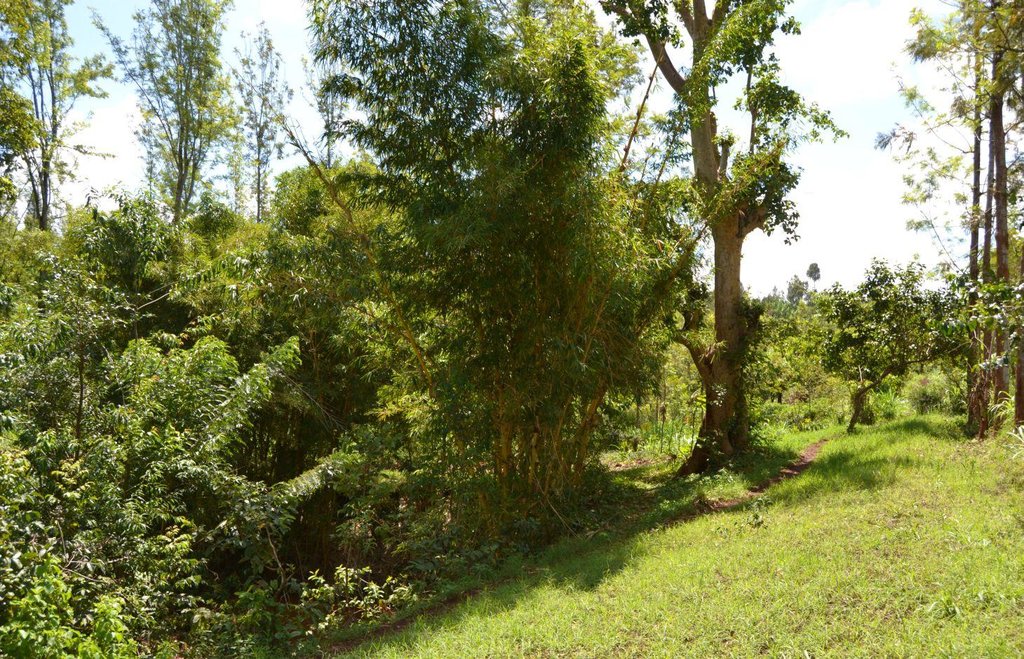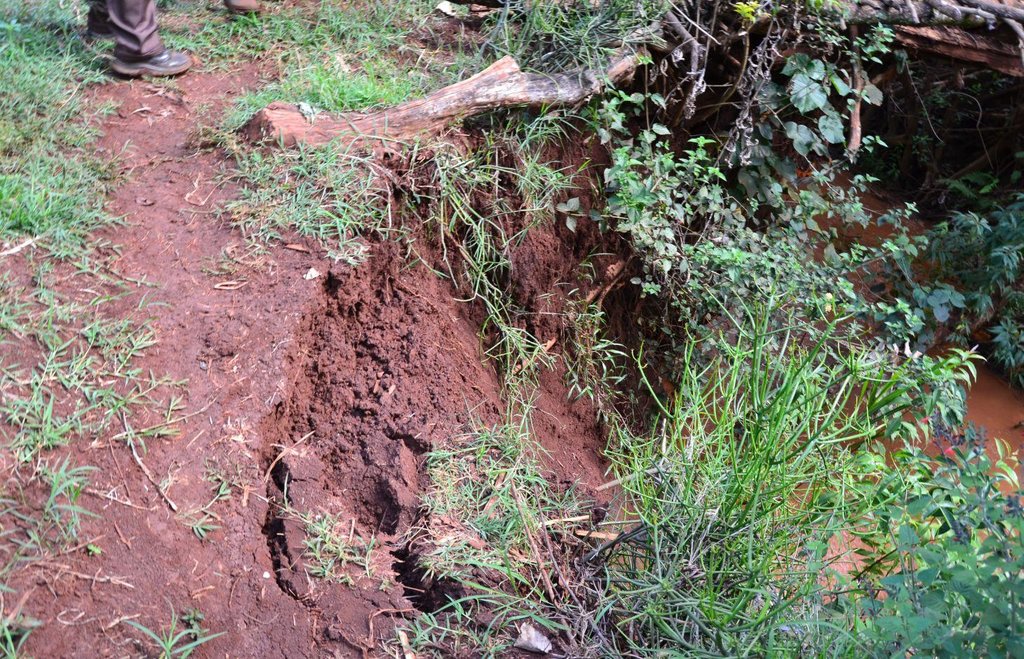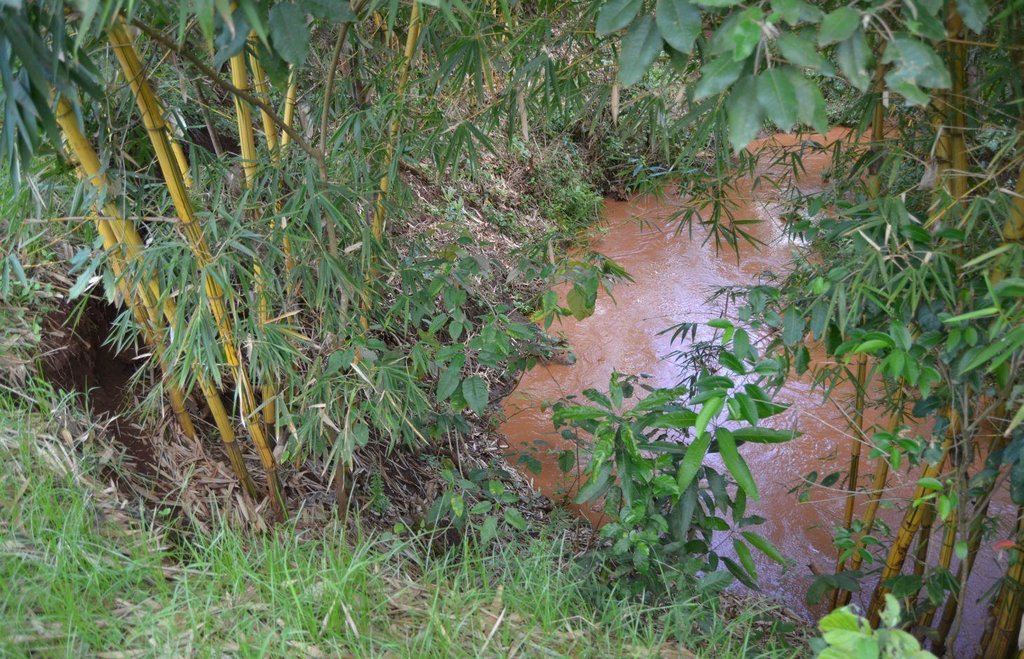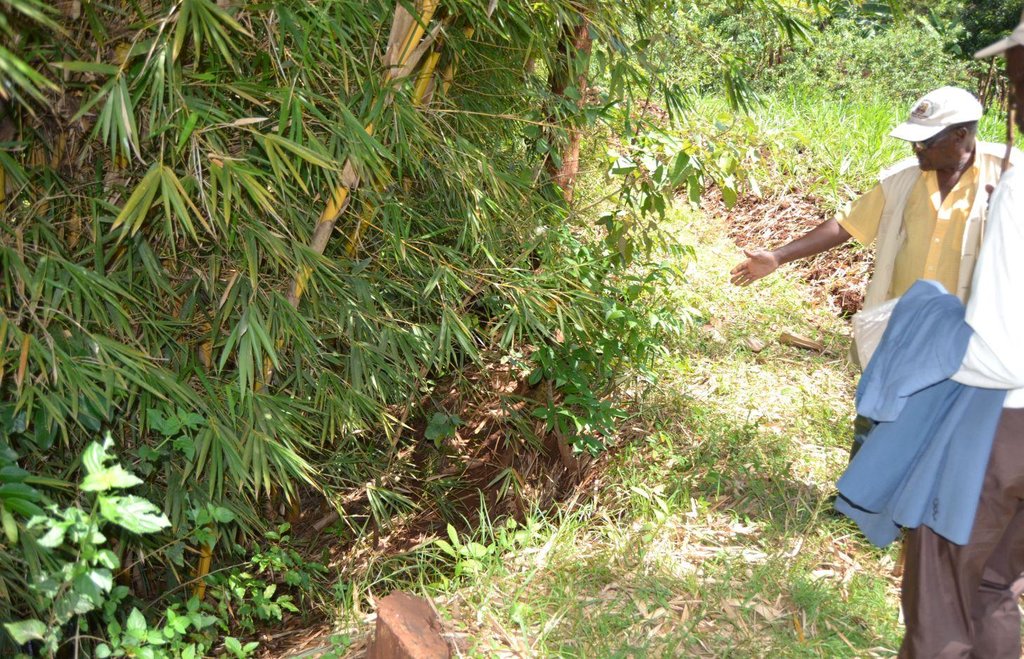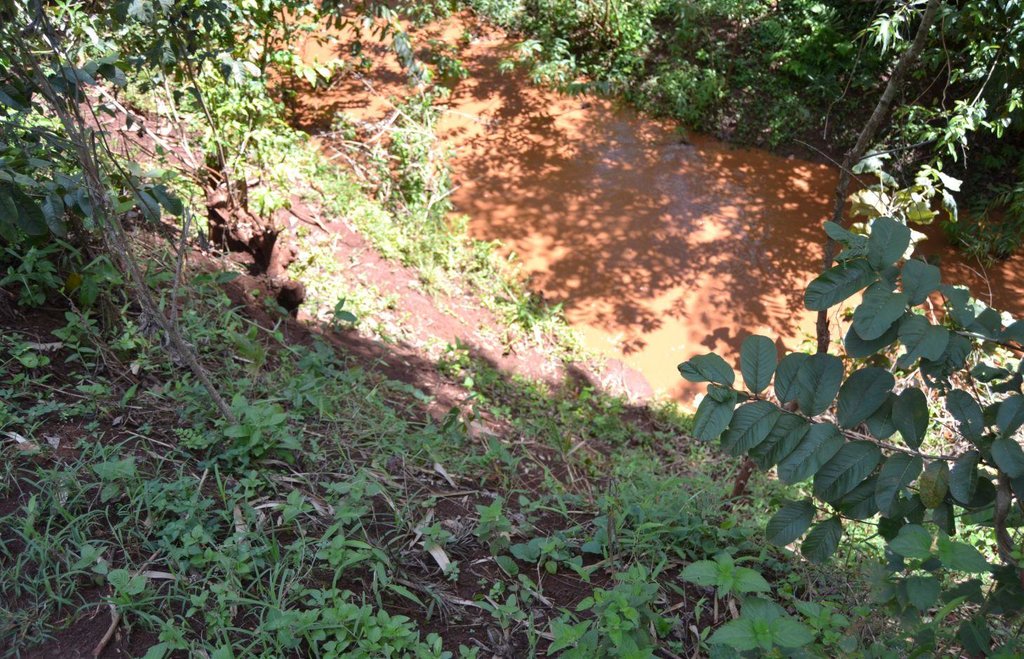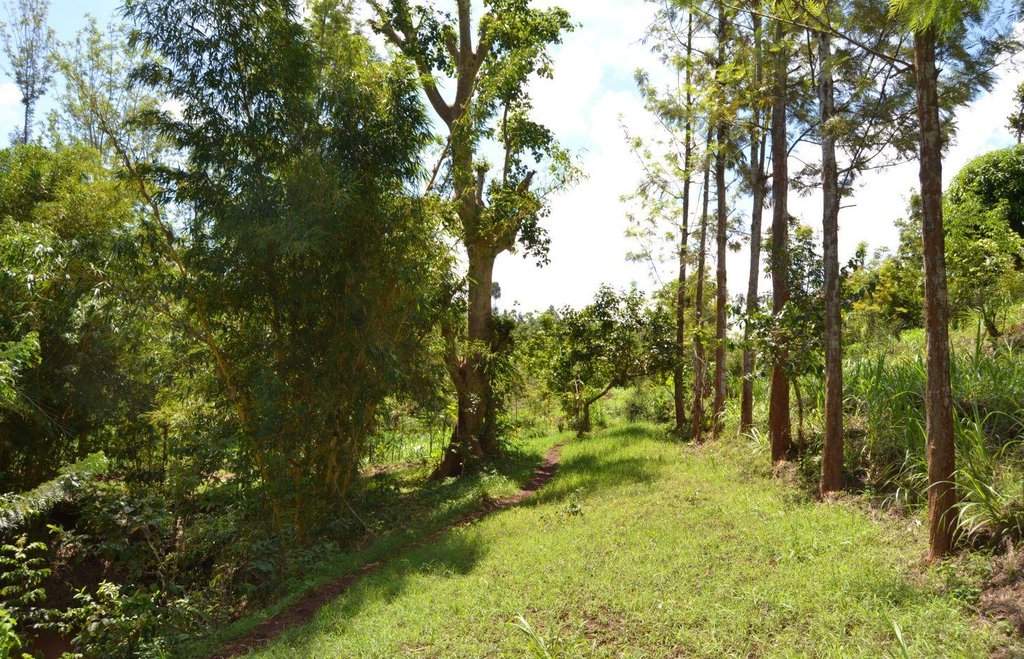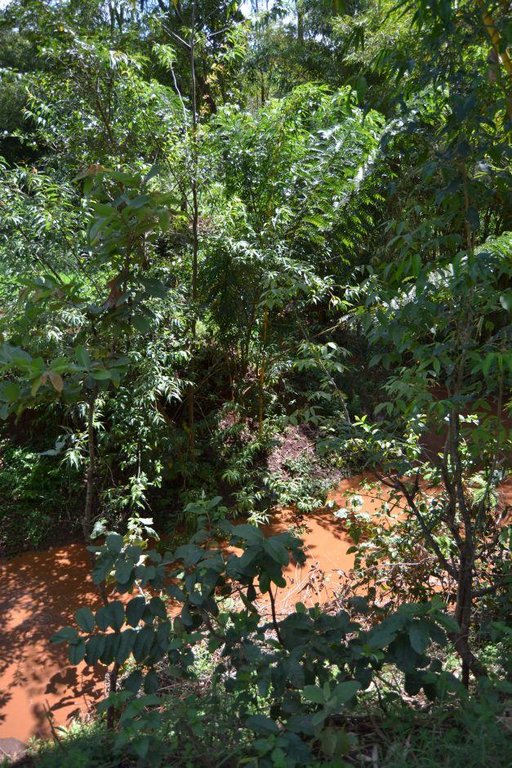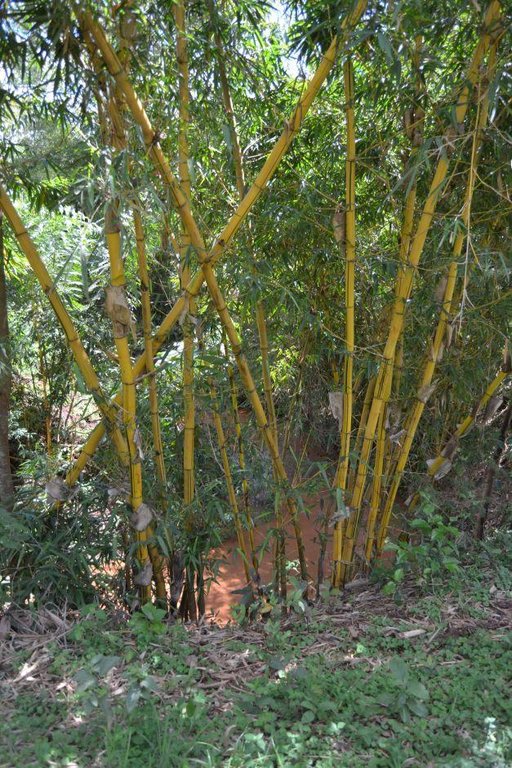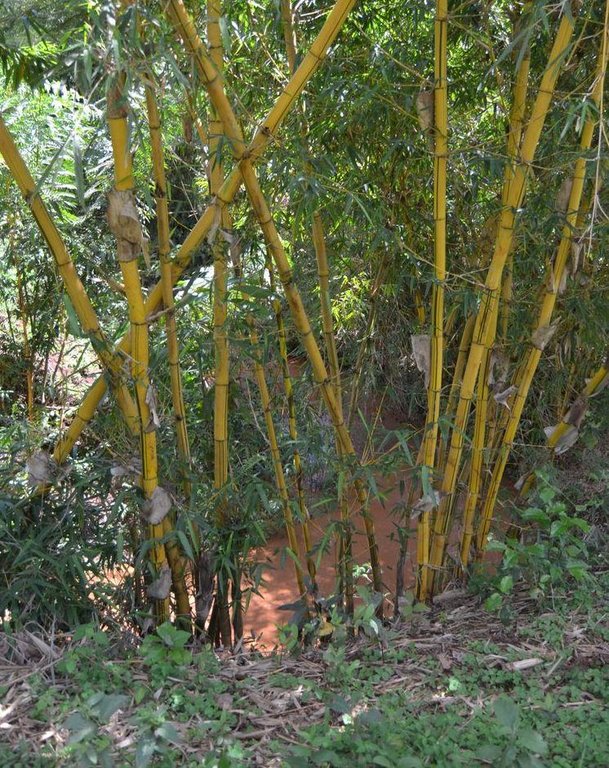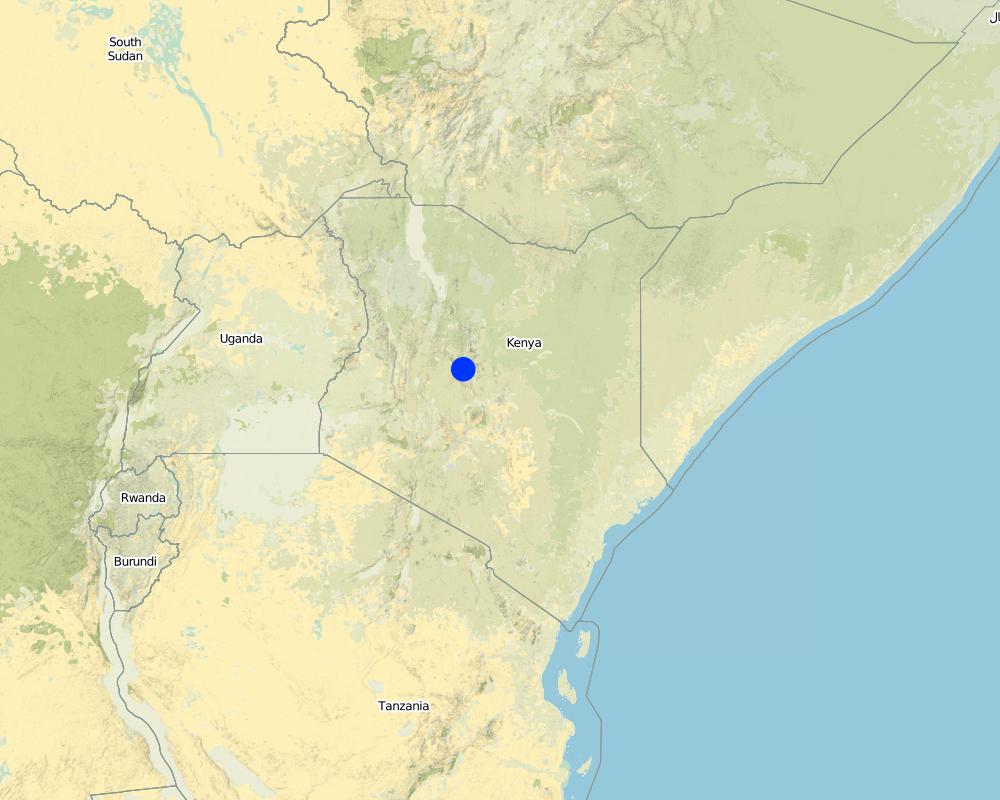Planting Bamboes and Grevillea for Riparian Land Conservation [Quênia]
- Criação:
- Atualização:
- Compilador/a: Laura D'Aietti
- Editor: –
- Revisores: David Streiff, Alexandra Gavilano
technologies_1135 - Quênia
Veja as seções
Expandir tudo Recolher tudo1. Informação geral
1.2 Detalhes do contato das pessoas capacitadas e instituições envolvidas na avaliação e documentação da tecnologia
Especialista em GST:
F. K. Nyamu Joseph
Saba Saba WRUA
Quênia
Nome da(s) instituição(ões) que facilitou(ram) a documentação/ avaliação da Tecnologia (se relevante)
FAO Food and Agriculture Organization (FAO Food and Agriculture Organization) - ItáliaNome da(s) instituição(ões) que facilitou(ram) a documentação/ avaliação da Tecnologia (se relevante)
Saba Saba Water Resource Users Association (Saba Saba WRUA) - Quênia1.3 Condições em relação ao uso da informação documentada através de WOCAT
O compilador e a(s) pessoa(s) capacitada(s) aceitam as condições relativas ao uso de dados documentados através do WOCAT:
Sim
2. Descrição da tecnologia de GST
2.1 Descrição curta da tecnologia
Definição da tecnologia:
The technology is based on tree plantation of several species (i.e. Grevillea robusta, Psidium guava, Bambusa vulgaris ) along the riparian land of the farmer.
2.2 Descrição detalhada da tecnologia
Descrição:
The practice carried out voluntary by the farmer consists of planting trees at the edge of the river bank and in its proximity.
Purpose of the Technology: By increasing vegetation cover (started 10 year ago) the intention of the farmer is to reduce and control bank erosion and landslides in the riparian land.
The degradation in this area is in fact evident and it is partially explained by the reduced vegetative cover. The planted trees help to maintain water quality by filtering silt and organic materials from rainwater runoff from the upper area and at the same time reinforce the streambank to control erosion. Another important environmental benefit is the increased carbon allocation from the new root systems.
The farmer also mentioned the interest to continue expanding tree plantation also in view of carbon credit and financial support from local authorities: in particular bamboo, which reaches maturity in few years, can be harvested after about two years and is easy to propagate (vegetatively).
Grevillea trees (timber) are seen by the farmer as a form of saving, and sold out when the farmer is in need of cash, earning between 800 up to 1500 KSh (Kenyan Shillings), depending on the size of the tree and the costs for cutting- transportation (e.g. machine operator between 500-700 KSh).
Establishment / maintenance activities and inputs: The initial inputs for the establishment of the vegetative practices concern mainly labour (e.g. planting trees) and the cost of the seedlings (10 KSh seedlings of Grevillea, 20 KSh of Guava); generally these activities are carried out at the beginning of the rainy season. Pruning of Grevillea is done every three seasons.
Natural / human environment: The climate is sub humid with two rainy seasons (the first starts around March and the second around October). Near the river the area is characterized by gentle slope and deposition of sediments and bank erosion are the main processes; the risks of further degradation and water pollution are reduced by the riparian vegetation and thanks to the good land management practices of the surrounding farmers. The riparian land is the area of min 6-30 m around the river and it is considered by law a protected area; therefore it should be left intact from any human activity (Water Act, 2002). Indeed, the 'control' and daily management is carried out by the riparian farmers in collaboration with Sabasaba WRUA and WRMA, the official authority for the management of the water of the river and the riparian land.
In this site in particular, the water of the river is considered clean by the farmer interviewed, despite the fact that during rainy seasons the sediment loads affect the quality of the water.
2.3 Fotos da tecnologia
2.5 País/região/locais onde a tecnologia foi aplicada e que estão cobertos nesta avaliação
País:
Quênia
Região/Estado/Província:
Kenya
Especificação adicional de localização:
GATWAMIKWA village, Kagurumo sublocation, Muthithi location
Comentários:
Total area covered by the SLM Technology is 0,1 ha m2.
Map
×2.6 Data da implementação
Caso o ano exato seja desconhecido, indique a data aproximada:
- menos de 10 anos atrás (recentemente)
2.7 Introdução da tecnologia
Especifique como a tecnologia foi introduzida:
- atráves de inovação dos usuários da terra
Comentários (tipos de projeto, etc.):
Since year 2000 the farmer has been adopted SWC practices: this in reply to the prolonged degrading situation at the hedge of the river: 'natural vegetation was 'not good' and so 'it was no properly holding the soil', he said.
3. Classificação da tecnologia de GST
3.1 Principal/principais finalidade(s) da tecnologia
- Reduz, previne, recupera a degradação do solo
3.2 Tipo(s) atualizado(s) de uso da terra onde a tecnologia foi aplicada

Terra de cultivo
- Cultura de árvores e arbustos
Cultivo de árvores e arbustos - Especificar culturas:
- manga, mangostão, goiaba
Número de estações de cultivo por ano:
- 2
Especifique:
Longest growing period in days: 122 Longest growing period from month to month: from about March to June Second longest growing period in days: 61 Second longest growing period from month to month: from about October to November

Floresta/bosques
- few lines of Grevillea/Bamboes (According to the definitions adopted FAO (FRA, 2010) the land could not be considered as wooded land (less than 0.5 ha).)
Tipo de árvore:
- Bambu de bambu
- Grevillea robusta
Produtos e serviços:
- Conservação/proteção da natureza
- source of cash
Comentários:
Tree plantation of several species (i.e. Grevillea robusta, Psidium guava, Bambusa vulgaris )
Major land use problems (compiler’s opinion): Risk of bank erosion and deposition of sediments in the river. See Appendix 3. Fig. 2.
Major land use problems (land users’ perception): Bank erosion. See Appendix 3. Fig. 3
Other type of forest: few lines of Grevillea/Bamboes: According to the definitions adopted FAO (FRA, 2010) the land could not be considered as wooded land (less than 0.5 ha).
Problems / comments regarding forest use: Bamboos are planted because of environmental benefits of this plant to stabilize riverbank. Other potential uses: e.g. wood is used to make baskets, fences and various kind of construction; leaves are used to feed chickens. The hollow sections between nodes are used to make containers. Indeed, the farmer let neighbours to clear and use some bamboos.
Forest products and services: nature conservation / protection
Other forest products and services: source of cash
3.5 Grupo de GST ao qual pertence a tecnologia
- Solo/cobertura vegetal melhorada
- variedades vegetal/raças de animais melhoradas
3.6 Medidas de GST contendo a tecnologia

Medidas agronômicas
- A7: Outros

Medidas vegetativas
- V1: cobertura de árvores/arbustos
Comentários:
Main measures: vegetative measures
Secondary measures: agronomic measures
Type of vegetative measures: aligned: -along boundary, scattered / dispersed
3.7 Principais tipos de degradação da terra abordados pela tecnologia

Erosão do solo pela água
- Wm: movimento de massas/deslizamentos
- Wr: erosão das margens

Degradação da água
- Hp: declínio da qualidade de água de superfície
Comentários:
Main type of degradation addressed: Wr: riverbank erosion, Hp: decline of surface water quality
Secondary types of degradation addressed: Wm: mass movements / landslides
Main causes of degradation: deforestation / removal of natural vegetation (incl. forest fires) (Poor vegetation cover, mainly herbaceous), Heavy / extreme rainfall (intensity/amounts) (Especially during wet seasons: March-June and October-November)
Secondary causes of degradation: other natural causes (avalanches, volcanic eruptions, mud flows, highly susceptible natural resources, extreme topography, etc.) specify (Footslope area (sediments deposition)), land tenure (Previous poor management SWC measures, especially in the upper areas)
3.8 Redução, prevenção ou recuperação da degradação do solo
Especifique o objetivo da tecnologia em relação a degradação da terra:
- Prevenir degradação do solo
- Reduzir a degradação do solo
Comentários:
Secondary goals: prevention of land degradation
4. Especificações técnicas, implementação de atividades, entradas e custos
4.1 Desenho técnico da tecnologia
Especificações técnicas (relacionada ao desenho técnico):
Bamboos planted at the hedge of the river; a line of Grevillea, which demarcate the farmer's property and Guava seedlings planted in the riparian land.
Technical knowledge required for land users: low (E.g. Planting bamboos is easy since colony species which use rhizome to spread.)
Main technical functions: control of dispersed runoff: impede / retard, improvement of ground cover, stabilisation of soil (eg by tree roots against land slides), improvement of water quality, buffering / filtering water
Secondary technical functions: improvement of topsoil structure (compaction), increase of infiltration, increase / maintain water stored in soil, sediment retention / trapping, sediment harvesting, promotion of vegetation species and varieties (quality, eg palatable fodder)
Aligned: -along boundary
Vegetative material: T : trees / shrubs
Number of plants per (ha): 25
Vertical interval within rows / strips / blocks (m): 1.5
Width within rows / strips / blocks (m): 0.5
Scattered / dispersed
Vegetative material: T : trees / shrubs, F : fruit trees / shrubs
Number of plants per (ha): 55
Vertical interval within rows / strips / blocks (m): few cm
Trees/ shrubs species: (25) Grevillea robusta (Mũkĩma)
Fruit trees / shrubs species: (5) Psidium guajava (Mũbera), (50 sps) Bambusa vulgaris (Mũrangi)
Slope (which determines the spacing indicated above): 3%
4.2 Informação geral em relação ao cálculo de entradas e custos
Especifique a moeda utilizada para os cálculos de custo:
- USD
4.3 Atividades de implantação
| Atividade | Periodicidade (estação do ano) | |
|---|---|---|
| 1. | Digging holes / Planting pits (1 feet×1feet Grevillea) | Beginning of the season (March/April) |
4.4 Custos e entradas necessárias para a implantação
| Especifique a entrada | Unidade | Quantidade | Custos por unidade | Custos totais por entrada | % dos custos arcados pelos usuários da terra | |
|---|---|---|---|---|---|---|
| Mão-de-obra | Digging holes | Persons/day | 4,0 | 1,75 | 7,0 | 100,0 |
| Material vegetal | Seedlings Grevillea | pieces | 25,0 | 0,28 | 7,0 | 100,0 |
| Material vegetal | Seedlings Guava | pieces | 5,0 | 0,2 | 1,0 | 100,0 |
| Custos totais para a implantação da tecnologia | 15,0 | |||||
| Custos totais para o estabelecimento da Tecnologia em USD | 15,0 | |||||
4.5 Atividades recorrentes/manutenção
| Atividade | Periodicidade/frequência | |
|---|---|---|
| 1. | Pruning Grevillea and let branches dry for firewood | Every 3 seasons |
| 2. | Clearing Grevillea for sale | When in need of cash (not regularly), at least 5 years after planting |
4.6 Custos e entradas necessárias pata a manutenção/atividades recorrentes (por ano)
| Especifique a entrada | Unidade | Quantidade | Custos por unidade | Custos totais por entrada | % dos custos arcados pelos usuários da terra | |
|---|---|---|---|---|---|---|
| Mão-de-obra | Pruning Grevillea | Persons/day | 1,0 | 4,0 | 4,0 | 100,0 |
| Mão-de-obra | Clearing Grevillea for sale | Persons/day | 1,0 | 7,0 | 7,0 | 100,0 |
| Custos totais para a manutenção da tecnologia | 11,0 | |||||
| Custos totais de manutenção da Tecnologia em USD | 11,0 | |||||
Comentários:
Machinery/ tools: shovel, machete, hoe
The costs summarized above have been calculated considering one year activities; Bamboos do not require establishment/maintenance costs and therefore do not appear in the balance sheet costs.
4.7 Fatores mais importantes que afetam os custos
Descreva os fatores mais determinantes que afetam os custos:
An important constraining factor is labour cost for clearing Grevillea.
5. Ambiente natural e humano
5.1 Clima
Precipitação pluviométrica anual
- <250 mm
- 251-500 mm
- 501-750 mm
- 751-1.000 mm
- 1.001-1.500 mm
- 1.501-2.000 mm
- 2.001-3.000 mm
- 3.001-4.000 mm
- > 4.000 mm
Especificações/comentários sobre a pluviosidade:
Two wet seasons: March-June and October-November. Dry periods: December- February and July- October
Zona agroclimática
- Subúmido
Thermal climate class: subtropics. June, July and August
5.2 Topografia
Declividade média:
- Plano (0-2%)
- Suave ondulado (3-5%)
- Ondulado (6-10%)
- Moderadamente ondulado (11-15%)
- Forte ondulado (16-30%)
- Montanhoso (31-60%)
- Escarpado (>60%)
Formas de relevo:
- Planalto/planície
- Cumes
- Encosta de serra
- Encosta de morro
- Sopés
- Fundos de vale
Zona de altitude:
- 0-100 m s.n.m.
- 101-500 m s.n.m.
- 501-1.000 m s.n.m.
- 1.001-1.500 m s.n.m.
- 1.501-2.000 m s.n.m.
- 2.001-2.500 m s.n.m.
- 2.501-3.000 m s.n.m.
- 3.001-4.000 m s.n.m.
- > 4.000 m s.n.m.
Comentários e outras especificações sobre a topografia:
Altitudinal zone: 1434 m a.s.l.
Landforms: Footslopes are the the areas in which this technology has maximum extent.
Slopes on average: Gentle in the riparian land.
5.3 Solos
Profundidade do solo em média:
- Muito raso (0-20 cm)
- Raso (21-50 cm)
- Moderadamente profundo (51-80 cm)
- Profundo (81-120 cm)
- Muito profundo (>120 cm)
Textura do solo (solo superficial):
- Médio (limoso, siltoso)
Matéria orgânica do solo superficial:
- Baixo (<1%)
Caso disponível anexe a descrição completa do solo ou especifique as informações disponíveis, p. ex. tipo de solo, PH/acidez do solo, nitrogênio, capacidade de troca catiônica, salinidade, etc.
Soil fertility is low
Soil drainage / infiltration is medium
Soil water storage capacity is medium
5.4 Disponibilidade e qualidade de água
Lençol freático:
> 50 m
Disponibilidade de água de superfície:
Médio
Qualidade da água (não tratada):
Água potável boa
5.5 Biodiversidade
Diversidade de espécies:
- Médio
5.6 Características dos usuários da terra que utilizam a tecnologia
Orientação de mercado do sistema de produção:
- Comercial/mercado
Rendimento não agrícola:
- >50% de toda renda
Nível relativo de riqueza:
- Rico
Indivíduos ou grupos:
- Indivíduo/unidade familiar
Indique outras características relevantes dos usuários da terra:
Population density: 10-50 persons/km2
Annual population growth: 2% - 3%
Off-farm income specification: The farmer is rich because he owns 3 acre of land and livestock, assets (electricity) which are above the average standards of the community. The farmer is retired from an accountancy service position several years ago.
Market orientation of production system: Timber of Grevillea is sold in feet.
5.7 Área média de terrenos utilizados pelos usuários de terrenos que aplicam a Tecnologia
- < 0,5 ha
- 0,5-1 ha
- 1-2 ha
- 2-5 ha
- 5-15 ha
- 15-50 ha
- 50-100 ha
- 100-500 ha
- 500-1.000 ha
- 1.000-10.000 ha
- > 10.000 ha
Comentários:
The area for planting Grevillea is just a strip along the riparian land.
5.8 Propriedade de terra, direitos de uso da terra e de uso da água
Propriedade da terra:
- Indivíduo, intitulado
Direitos do uso da terra:
- Indivíduo
Direitos do uso da água:
- Acesso livre (não organizado)
Comentários:
Water use rights depend on the use: open access for drinking and domestic uses.
5.9 Acesso a serviços e infraestrutura
Saúde:
- Pobre
- Moderado
- Bom
Educação:
- Pobre
- Moderado
- Bom
Assistência técnica:
- Pobre
- Moderado
- Bom
Emprego (p. ex. não agrícola):
- Pobre
- Moderado
- Bom
Mercados:
- Pobre
- Moderado
- Bom
Energia:
- Pobre
- Moderado
- Bom
Vias e transporte:
- Pobre
- Moderado
- Bom
Água potável e saneamento:
- Pobre
- Moderado
- Bom
Serviços financeiros:
- Pobre
- Moderado
- Bom
6. Impactos e declarações finais
6.1 Impactos no local mostrados pela tecnologia
Impactos socioeconômicos
Produção
Produção de forragens
Produção de madeira
Área de produção
Disponibilidade e qualidade de água
Disponibilidade de água para irrigação
Comentários/especificar:
Could be the case for Napier grass if long dry spells occur
Demanda por água para irrigação
Renda e custos
Despesas com insumos agrícolas
Rendimento agrícola
Diversidade de fontes de rendimento
Carga de trabalho
Impactos socioculturais
Segurança alimentar/auto-suficiência
Comentários/especificar:
Indirectly another source of income that could improve in maintaining FS conditions at household level
Instituições comunitárias
Comentários/especificar:
The shared knowledge/benefits help to build community solidarity, strengthening linkages between farmers
Conhecimento de GST/ degradação da terra
Comentários/especificar:
The importance of the benefits of Bamboos and other sps. to the river in preventing erosion and improving water quality has encouraged neighbours to adopt the same veg. measures (fig. 8)
Impactos ecológicos
Ciclo hídrico/escoamento
Qualidade de água
Escoamento superficial
Evaporação
Solo
Umidade do solo
Cobertura do solo
Perda de solo
Biodiversidade: vegetação, animais
Biomassa/carbono acima do solo
Diversidade de habitat
Comentários/especificar:
Especially Bamboo's canopy which create a good habitat for birds
Controle de praga/doença
Comentários/especificar:
Expanding bamboo's plantation could attract rodents/rats feeded off the bamboo's fruits, grains.
Outros impactos ecológicos
Carbon credit
Comentários/especificar:
Beginning phase of the process of acquiring CC.
6.2 Impactos externos mostrados pela tecnologia
Disponibilidade de água
Caudal confiável e estável em período seco
Sedimentação a jusante
Poluição de água subterrânea/rio
Capacidade de tamponamento/filtragem
6.3 Exposição e sensibilidade da tecnologia às mudanças climáticas graduais e extremos/desastres relacionados ao clima (conforme o ponto de vista dos usuários da terra)
Mudança climática gradual
Mudança climática gradual
| Estação do ano | aumento ou diminuição | Como a tecnologia lida com isso? | |
|---|---|---|---|
| Temperatura anual | aumento | não conhecido |
Extremos (desastres) relacionados ao clima
Desastres meteorológicos
| Como a tecnologia lida com isso? | |
|---|---|
| Temporal local | bem |
| Tempestade de vento local | bem |
Desastres climatológicos
| Como a tecnologia lida com isso? | |
|---|---|
| Seca | não bem |
Desastres hidrológicos
| Como a tecnologia lida com isso? | |
|---|---|
| Inundação geral (rio) | bem |
Outras consequências relacionadas ao clima
Outras consequências relacionadas ao clima
| Como a tecnologia lida com isso? | |
|---|---|
| Período de crescimento reduzido | não conhecido |
6.4 Análise do custo-benefício
Como os benefícios se comparam aos custos de implantação (do ponto de vista dos usuários da terra)?
Retornos a curto prazo:
neutro/balanceado
Retornos a longo prazo:
levemente positivo
Como os benefícios se comparam aos custos recorrentes/de manutenção(do ponto de vista dos usuários da terra)?
Retornos a curto prazo:
neutro/balanceado
Retornos a longo prazo:
levemente positivo
6.5 Adoção da tecnologia
- casos isolados/experimental
De todos aqueles que adotaram a Tecnologia, quantos o fizeram espontaneamente, ou seja, sem receber nenhum incentivo/ pagamento material?
- 0-10%
Comentários:
100% of land user families have adopted the Technology with external material support
There is a moderate trend towards spontaneous adoption of the Technology
6.7 Pontos fortes/vantagens/oportunidades da tecnologia
| Pontos fortes/vantagens/oportunidades na visão do usuário da terra |
|---|
|
Grevillea is good for timber producion. How can they be sustained / enhanced? More trees could be planted, but because of 'lack of money' he can not afford it. |
|
Bamboos are good in holding the soil How can they be sustained / enhanced? Leaves could be actually used to feed chickens; planting the 'giant bamboos' also for food consumption. |
| Pontos fortes/vantagens/oportunidades na visão do compilador ou de outra pessoa capacitada |
|---|
|
The Technology is easy to adopt, specially Bamboos plantation, since it does not require significant input and knowledge How can they be sustained / enhanced? It could be implemented in the long run also because the farmer is willing to earmark part of his land for a nursery. The intention is to support the nursery with free seedlings, which could be later distributed among the riparian farmers of the community. |
|
Bambos spreads easily through cuttings and it has different beneficial uses (baskets, fences and various kinds of construction). How can they be sustained / enhanced? Other type of Bamboos could be used as: Dendrocalamus giganteus for food consumption and Arundinaria alpina. |
|
Grevillea plantation has benefits in holding soil. It helps to reduce evaporation from the soil since it makes good shadow. How can they be sustained / enhanced? To increase biodiversity other indigenous sps. could be also planted, among others: Croton megalocarpus (Mũkindũri) a medicinal tree that attracts a lot of bees when in flower, resulting in excellent white honey. The seeds contain oil. Sesbania sesban/keniensis (Mwethia), a nitrogen fixers plant which therefore helps to increase soil fertility. |
7. Referências e links
7.1 Métodos/fontes de informação
7.2 Referências às publicações disponíveis
Título, autor, ano, ISBN:
Kikuyu botanical Dictionary 2nd Ed.:A guide to plants names, uses and cultural values. Muruga Gachathi, 2007.
Disponível de onde? Custos?
KEFRI, Nairobi
7.3 Links para informações on-line relevantes
Título/ descrição:
Smallholder timber and firewood marketing in the coffee and cotton/tobacco zones ofeastern Mount Kenya. Holding et al., 2006.
URL:
http://www.coford.ie/media/coford/content/publications/projectreports/small-scaleforestryconference/Holding.pdf
Título/ descrição:
Lovett, S. & Price, P. (eds), 2007, Principles for riparian lands management, Land & Water Australia, Canberra. (Ch. 2 Diversity and dynamics of riparian vegetation, Ch.6 The influence of riparian management on stream erosion)
URL:
http://lwa.gov.au/files/products/river-landscapes/px061170/px061170-chapter-1.pdf
Título/ descrição:
Water Act (The), 2002. N8. The National Water Services Strategy
URL:
http://faolex.fao.org/docs/pdf/ken37553-a.pdf and http://faolex.fao.org/docs/pdf/ken37553-b.pdf
Links e módulos
Expandir tudo Recolher tudoLinks
Não há links
Módulos
Não há módulos


